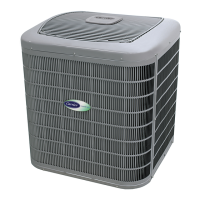continues, the control will energize the compressor contactor every
15 minutes. If the thermal protector closes, (at the next 15 minute
interval check) the unit will resume operation.
If the thermal cutout trips for three consecutive cycles, then unit
operation is locked out for 4 hours and the appropriate fault code is
displayed.
Low or High Contactor Open (25HNA6 models) / No
230V at Compressor Contactor (25HNA9 models)
If the compressor voltage is not sensed when the compressor
should be starting, the appropriate contactor may be stuck open or
there is a wiring error. The control will flash the appropriate fault
code. Check the contactor and control box wiring.
25HNA6 Models Only - Compressor Start Detection
on Models with Bristol Compressors Only
In low stage, if the specified start voltage at VR terminal is not
achieved, the start relay is de-energized after 1 second and the
control will flash the appropriate fault code.
In high stage, if the specified start voltage at VS terminal is not
achieved, the start relay is de-energized after 1 second and the
control will flash the appropriate fault code.
If the specified start voltage is not achieved for 3 consecutive low
stage starts, low stage operation is locked out for 30 minutes. If the
specified start voltage is not achieved for 3 consecutive high stage
starts, high stage operation is locked out for 30 minutes. The
control will flash the appropriate fault code.
Troubleshooting 25HNA6 units for proper switching
between low & high sta_es
Check the suction and liquid pressures at the service valves.
Suction pressure should be reduced by 5-10% when switching
from low to high capacity. There should be a 10-20% increase in
liquid pressure when switching from low to high capacity.
Compressor current should increase 100-250% when switching
from low to high stage.
Troubleshooting 25HNA9 units for proper switching
between low & high sta_es
Check the suction pressures at the service valves. Suction pressure
should be reduced by 3-10% when switching from low to high
capacity.
NOTE: The liquid pressures are very similar between low and
high stage operation, so liquid pressure should not be used for
troubleshooting.
Compressor current should increase 20-45% when switching from
low to high stage. The compressor solenoid when energized in
high stage, should measure 24vac.
When the compressor is operating in low stage the 24v DC
compressor solenoid coil is de-energized. When the compressor is
operating in high stage, the 24v DC solenoid coil is energized. The
solenoid plug harness that is connected to the compressor HAS an
internal rectifier that converts the 24v DC signal to 24v AC. DO
NOT INSTALL A PLUG WITHOUT AN INTERNAL
RECTIFIER.
Unloader Test Procedure
The unloader is the compressor internal mechanism, controlled by
the DC solenoid, that modulates between high and low stage. If it
is suspected that the unloader is not working, the following
methods may be used to verify operation.
1. Operate the system and measure compressor amperage.
Cycle the unloader on and off at 30 second plus intervals at
the UI (from low to high stage and back to low stage). Wait
5 seconds after staging to high before taking a reading. The
compressor amperage should go up or down at least 20 per-
cent.
2. If the expected result is not achieved, remove the solenoid
plug from the compressor and with the unit running and the
UI calling for high stage, test the voltage output at the plug
with a DC voltmeter. The reading should be 24 volts DC.
3. If the correct DC voltage is at the control circuit molded
plug, measure the compressor unloader coil resistance. The
resistance should be 32 to 60 ohms depending on com-
pressor temperature. If the coil resistance is infinity, nmch
lower than 32 ohms, or is grounded, the compressor nmst
be replaced.
Temperature Thermistors
Thermistors areelectronic devices which sense temperature. As the
temperature increases, the resistance decreases. Thermistors are
used to sense outdoor air (OAT) and coil temperature (OCT).
Refer to Fig. 7 for resistance values versus temperature.
THERMISTOR CURVE
9o1 _ r ] r q
| _ I I I I I |
701 t , t , 1
6o4 'v4 L I _ I 4
U 5°1 t I t I 1
z 404 _\ • I • I J
_< / ",. I i i i /
co 301 m _ I t I 1
/ i /
10 t _ t _ 1
0 20 40 60 80 100 120
(-17.77) (-6.67) (4.44) (15.56) (26.67) (37.78) (48.89)
TEMPERATURE °F (°C)
A08054
Fig. 7 - Resistance Values Versus Temperature
If the outdoor air or coil thermistor should fail, the control will
flash the appropriate fault code. (See Table 60
IMPORTANT: The outdoor air thermistor and coil thermistor
should be factory mounted in the final locations. Check to ensure
thermistors are mounted properly per Fig. 8 and Fig. 9.
Thermistor Sensor Comparison
The control continuously monitors and compares the outdoor air
temperature sensor and outdoor coil temperature sensor to ensure
proper operating conditions, The comparison is:
• In cooling if the outdoor air sensor indicates -> 10°F
(->5.6 o C) warmer than the coil sensor (or) the outdoor air sensor
indicates ->20 °F (-> 11 oC) cooler than the coil sensor, the
sensors are out of range.
• In heating if the outdoor air sensor indicates ->35 °F (-> 19.4 ° C)
warmer than the coil sensor (or) the outdoor air sensor indicates
->10°F (-> 5.6°C) cooler than the coil sensor, the sensors are out
of range.
If the sensors are out of range, the control will flash the appropriate
fault code as shown in Table 6.
The thermistor comparison is not performed during low ambient
cooling or defrost operation,
12

